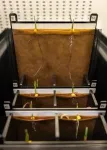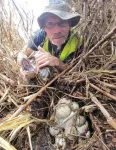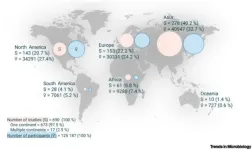(Press-News.org) A corn plant knows how to find water in soil with the very tips of its roots, but some varieties, including many used for breeding high-yielding corn in the U.S., appear to have lost a portion of that ability, according to a Stanford-led study. With climate change increasing droughts, the findings hold potential for developing more resilient varieties of corn.
The study, published in the journal Science, uncovers genetic mechanisms behind root “hydropatterning,” or how plant roots branch toward water and avoid dry spaces in soil. In particular, the researchers discovered that ethylene, a plant hormone known to help bananas ripen, also influences how roots grow to seek water.
“Plants are sophisticated in the way that they ‘see’ where water is in soil, and the genes that are responsible for that play an important role in helping the plant create a root system that is optimized for efficient water uptake,” said José Dinneny, the study’s senior author and a professor of biology in Stanford’s School of Humanities and Sciences.
Essentially, the plants use the gaseous ethylene produced by their roots to sense where the air spaces are in the soil, Dinneny said. Then, they regulate the branching of roots downstream of that hormone.
Water-seeking roots
While the Dinneny lab had previously revealed the fine sensitivity that corn roots have for detecting water, just how well a plant does this was found to heavily depend on the specific variety of corn.
For this study, the researchers developed a new, simplified way to study water sensitivity in roots, making it possible to analyze the responses of 250 corn varieties that reflect the genetic pool present in modern corn breeding. They found that corn varieties adapted to grow in tropical or subtropical areas like Mexico were very good at making new root branches toward water and avoiding dry areas. In contrast, the varieties adapted to temperate regions of North America frequently grew roots in many directions without distinguishing between dry and wet areas in the soil. This work was made possible through an international collaboration of several research groups contributing expertise in quantitative genetics, evolution, and root development.
The development of modern corn grown in the U.S., a major crop often grown on highly fertile agricultural lands, may have weakened the plants’ water-seeking root response, the researchers said. They also noted that comparisons to field studies showed that stronger hydropatterning was linked to greater root depth.
“Interestingly, the plants that are better at sensing where the water is are also making deeper root systems,” said lead author Johannes Scharwies, a postdoctoral scholar in Dinneny’s lab. “One hypothesis could be that if the plant doesn’t waste time growing root branches into places where it doesn’t find any water and nutrients, then it has more energy to grow deeper down where water is more likely.”
Targeting drought resilience
The researchers found through genetic analyses that two plant hormones, auxin and ethylene, play a role in how corn roots respond to water. While auxin was already known to help control this process, ethylene’s involvement was a new discovery. In experiments with thale cress (Arabidopsis thaliana) – a model plant often used in research – the researchers found that the genetic signaling pathways of the two hormones complement each other: Auxin signaling promotes root branch development toward water, while ethylene suppresses branching when the root is exposed to air.
Further research is needed to better understand the interaction of these genetic pathways before corn varieties can be developed with more drought-resilient root systems, but the findings underscore the importance of studying these localized responses at root tips, Scharwies said.
“Each root tip acts like a sensor in the soil. They forage for water and nutrients and control in which direction new root branches should be grown,” he said. “We need to spend more time looking at these very local root responses to understand what the whole plant does, and then we can use that to develop plants that are more resilient against drought.”
Additional co-authors on the study include life sciences technician Taylor Clarke, lab manager Andrea Dinneny, and postdoctoral scholar Héctor Torres-Martínez from Stanford as well as researchers from the Howard Hughes Medical Institute, Iowa State University, Norwegian University of Life Sciences, University of Oslo in Norway, University of Nottingham in the U.K., and the University of North Carolina, Chapel Hill.
This research received support from the Howard Hughes Medical Institute; U.S. Department of Energy; National Science Foundation; UKRI Frontiers Research, Biotechnology and Biological Sciences Research Council; European Research Council, Horizon Europe; and the Evotree project.
END
Large differences in water-seeking ability found in U.S. corn varieties
2025-02-06
ELSE PRESS RELEASES FROM THIS DATE:
Whale song has structure similar to human language
2025-02-06
Humpback whale song is a striking example of a complex, culturally transmitted behavior, but up to now, there was little evidence it has language-like structure. Human language, which is also culturally transmitted, has recurring parts whose frequency of use follows a particular pattern. In humans, these properties help learning and may come about because they help language be passed from one generation to the next. This work innovatively applies methods inspired by how babies discover words in speech to humpback whale recordings, uncovering the same statistical structures found in all human languages. It reveals previously undetected structure in ...
Cracking the Burmese python code: New data zeroes in on game-changing strategies
2025-02-06
In a groundbreaking study, University of Florida scientists statistically analyzed large amounts of data collected by Burmese python contractors, revealing critical insights about how to most efficiently remove the reptiles.
Researchers correlated survey outcomes, including python removals, with survey conditions, using statistical modeling. For example, the researchers examined if factors like time or temperature impacted the chance of removing a python. They also analyzed whether the most surveyed areas aligned with the highest python removals. This allowed the researchers to ...
Risk it or kick it? Study analyzes NFL coaches’ risk tolerance on fourth down
2025-02-06
During the Super Bowl, every decision matters. With millions of fans watching, the game often comes down to a single play call. And no call is more scrutinized than what a coach decides to do on fourth down. Punt? Attempt a field goal? Or go for it?
A new BYU study explains why NFL coaches, including Super Bowl contenders Andy Reid (Kansas City Chiefs) and Nick Sirianni (Philadelphia Eagles), may behave too conservatively on fourth down. Despite growing acceptance of analytics-driven decision-making, most coaches, ...
UC3M patents a new design for a soft robotic joint that is more adaptable and robust
2025-02-06
Researchers at Universidad Carlos III de Madrid (UC3M) have developed a new soft joint model for robots with an asymmetrical triangular structure and an extremely thin central column. This breakthrough, recently patented, allows for versatility of movement, adaptability and safety, and will have a major impact in the field of robotics.
“The main feature of this new design is that it allows greater bending angles to be achieved with less force, providing the robots with great versatility and adaptability of movement,” explains Concha Monje, professor in the UC3M Department ...
Nutrition labels meant to promote healthy eating could discourage purchases
2025-02-06
Some food labels designed to nudge Americans toward healthier food choices can have the opposite effect, new University of Florida research shows.
The study is particularly compelling because it comes as the U.S. Food and Drug Administration weighs whether to require front-of-package food labels. Through a newly proposed rule, the agency introduced labels highlighting saturated fat, sodium and added sugar. Each value on the labels, a percent of the recommended daily value, corresponds to one of three levels: low, medium and high.
The UF/IFAS study, published in the journal Food Policy, examined front-of-package labels professing the contents inside as “healthy.” ...
A new way to detect inflammation
2025-02-06
CLEVELAND—Nearly every disease has an inflammatory component, but blood tests can’t pinpoint inflammation in specific organs or tissues in the human body.
Now researchers at Case Western Reserve University have developed a method to detect inflammation using antibodies, potentially leading to blood tests for disease-specific biomarkers such as for heart disease, Alzheimer’s disease and various cancers. Their breakthrough also holds promise for drug discovery.
“This research opens up an amazing number of pathways ...
Crohn's & Colitis Congress® spotlights key IBD research findings
2025-02-06
San Francisco, CA (Feb. 5, 2025) – The Crohn’s & Colitis Foundation and the American Gastroenterological Association (AGA) are excited to host the annual Crohn’s & Colitis Congress®, taking place Feb. 6-8, in San Francisco, CA. This premier event will showcase cutting-edge research, innovative technologies, and advanced patient care strategies set to transform the lives of one in 100 Americans living with inflammatory bowel disease (IBD), including Crohn’s disease and ulcerative colitis.
Below ...
Vanilla farmers search for a crop and conservation sweet spot
2025-02-06
Vanilla is vital to the livelihoods of farmers in Madagascar, where the globally popular dessert ingredient is the country’s No. 1 export. A fun, thought-provoking game designed by a team of scientists and played by Malagasy vanilla farmers reveals the challenges of payment programs that incentivize forest conservation in the region, according to a study led by the University of California, Davis.
The study, published in the February issue of the journal Biological Conservation, found that even amid volatile markets and climate uncertainties, farmers highly value their vanilla crops, which are tied ...
Global “sisterhood” seeks to understand what makes a healthy vaginal microbiome
2025-02-06
Vaginas host a complex microcosm of bacteria and yeasts that can fluctuate over time. However, little is known about these microbial communities and their roles in a person’s health, and 9 out of 10 studies only include participants from one continent, resulting in major geographical gaps in data. In a paper publishing February 6 in the Cell Press journal Trends in Microbiology, scientists share insights gleaned from a “sisterhood” of thousands of citizen scientists and demonstrate how international collaboration can help illuminate the gaps in our knowledge about the vaginal microbiome, including which bacteria are helpful ...
Announcing the winners of the 5th annual Rising Black Scientists Awards
2025-02-06
Four early-career scientists share how they’ve harnessed features of their lives—from music to AI technology—to inspire their career and uplift communities. Each winner receives $10,000 for their science with essays published in the journal Cell
Cell Press, Cell Signaling Technology (CST), and the Elsevier Foundation are proud to announce the winners of the 5th annual Rising Black Scientists Awards: Jheannelle Johnson of Stanford University; Victor Ekuta, MD, of the Morehouse School of Medicine; Kenna Gloria Agbugba of Philander Smith ...











